There are several space stories we’re anticipating for 2016 but one story might appear — to some — to belong in the realm of science fiction: sometime in the coming year Elon Musk will likely reveal his plans for colonizing Mars.
Early in 2015, Musk hinted that he would be publicly disclosing his strategies for the Mars Colonial Transport system sometime in late 2015, but then later said the announcement would come in 2016.
“The Mars transport system will be a completely new architecture,” Musk said during a Reddit AMA in January 2015, replying to a question about the development of MCT. “[I] am hoping to present that towards the end of this year. Good thing we didn’t do it sooner, as we have learned a huge amount from Falcon and Dragon.”
Big Rockets
As far as any details, Musk only said that he wants to be able to send 100 colonists to Mars at a time, and the “goal is 100 metric tons of useful payload to the surface of Mars. This obviously requires a very big spaceship and booster system.”
He has supposedly dubbed the rocket the BFR (for Big F’n Rocket) and the spaceship similarly as BFS.
And he wants it to be reusable, which Musk and SpaceX have said is the key to making human life multiplanetary. The recent successful return and vertical landing of the Falcon 9’s first stage makes that closer to reality than ever.
While SpaceX has no publicly shared concept illustrations as of yet, a few enthusiasts on the web have shared their visions of MCT, such as this discussion on Reddit , and the drawing below by engineer John Gardi, who recently proposed his ideas for the MCT on Reddit.
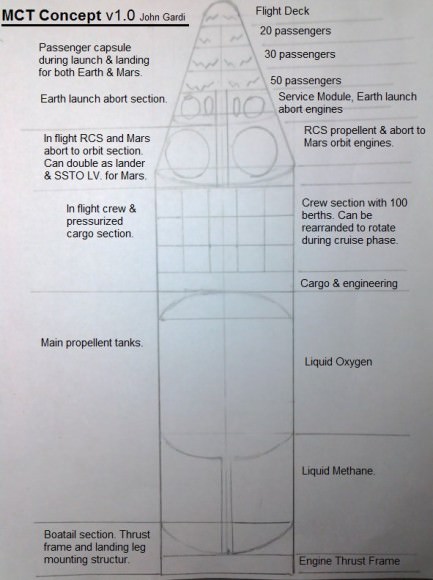
Most online discussions describe the MCT as an interplanetary ferry, with the spaceship built on the ground and launched into orbit in one piece and perhaps refueled in low Earth orbit. The transporter could be powered by Raptor engines, which are cryogenic methane-fueled rocket engines rumored to be under development by SpaceX.
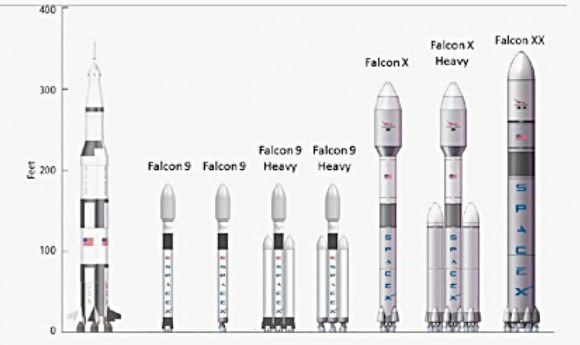
The Challenge of Landing Large Payloads on Mars
While the big rocket and spaceship may seem to be a big hurdle, an even larger challenge is how to land a payload of 100 metric tons with 100 colonists, as Musk proposes, on Mars surface.
As we’ve discussed previously, there is a “Supersonic Transition Problem” at Mars. Mars’ thin atmosphere does not provide an enough aerodynamics to land a large vehicle like we can on Earth, but it is thick enough that thrusters such as what was used by the Apollo landers can’t be used without encountering aerodynamic problems such as sheering and incredible stress on the vehicle.
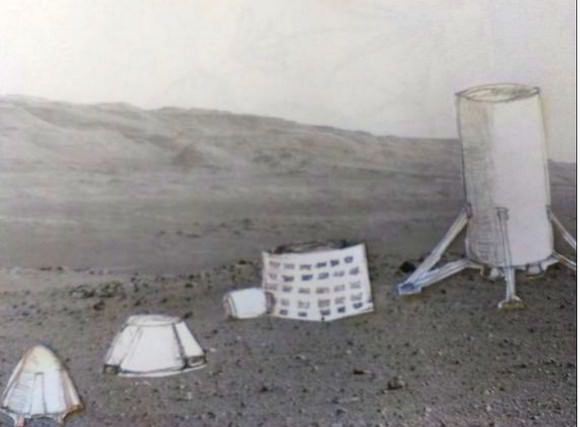
“Unique to Mars, there is a velocity-altitude gap below Mach 5,” explained Rob Manning from the Jet Propulsion Laboratory in our article from 2007. “The gap is between the delivery capability of large entry systems at Mars and the capability of super-and sub-sonic decelerator technologies to get below the speed of sound.”
With current landing technology, a large, heavy human-sized vehicle streaking through Mars’ thin, volatile atmosphere only has about 90 seconds to slow from Mach 5 to under Mach 1, change and re-orient itself from a being a spacecraft to a lander, deploy parachutes to slow down further, then use thrusters to translate to the landing site and gently touch down.
90 seconds is not enough time, and the airbags used for rovers like Spirit and Opportunity and even the Skycrane system used for the Curiosity rover can’t be scaled up enough to land the size of payloads needed for humans on Mars.
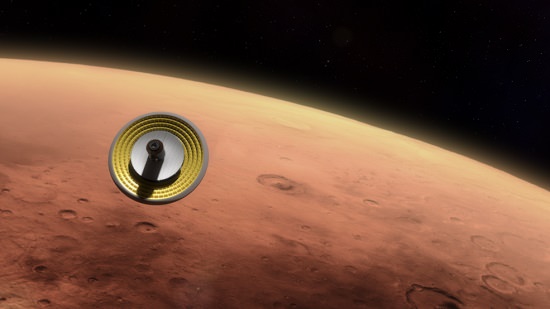
NASA has been addressing this problem to a small degree, and has tested out inflatable aeroshells that can provide enough aerodynamic drag to decelerate and deliver larger payloads. Called Hypersonic Inflatable Aerodynamic Decelerator (HIAD), this is the best hope on the horizon for landing large payloads on Mars.
The Inflatable Reentry Vehicle Experiment (IRVE-3) was tested successfully in 2012. It was made of high tech fabric and inflated to create the shape and structure similar to a mushroom. When inflated, the IRVE-3 is about 10-ft (3 meter) in diameter, and is composed of a seven giant braided Kevlar rings stacked and lashed together – then covered by a thermal blanket made up of layers of heat resistant materials. These kinds of aeroshells can also generate lift, which would allow for additional slowing of the vehicle.
“NASA is currently developing and flight testing HIADs — a new class of relatively lightweight deployable aeroshells that could safely deliver more than 22 tons to the surface of Mars,” said Steve Gaddis, GCD manager at NASA’s Langley Research Center in a press release from NASA in September 2015.
NASA is expecting that a crewed spacecraft landing on Mars would weigh between 15 and 30 tons, and the space agency is looking for ideas through its Big Idea Challenge for how to create aeroshells big enough to do the job.
With current technology, landing the 100 metric tons that Musk envisions might be out of reach. But if there’s someone who could figure it out and get it done, Elon Musk just might be that person.
Additional reading: Alan Boyle on Geekwire, GQ interview of Elon Musk.

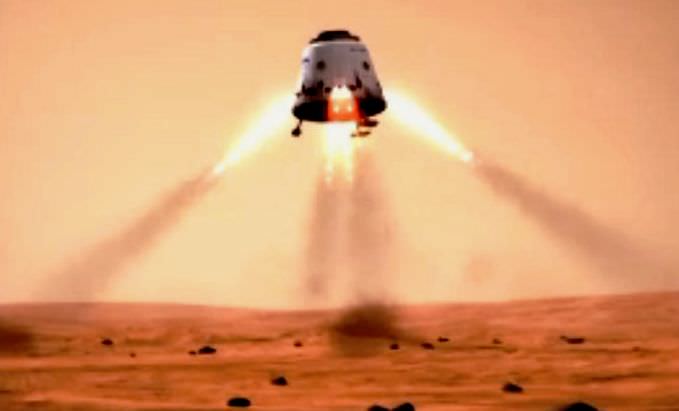
Happy New Year, everyone!
“With current technology, landing the 100 metric tons that Musk envisions might be out of reach. But if there’s someone who could figure it out and get it done, Elon Musk just might be that person.”
He likely already did 2010, and showed it worked 2013. NASA’s Red Dragon planning showed to their satisfaction that a Dragon [basic design 2010] can land 2 metric ton using, say, the martian northern low lying basin with supersonic retroburns [shown with Falcon 9 1st stage 2013] coming in at a low angle. [ https://www.youtube.com/watch?v=ZoSKHzziLKw ]
Essentially you have to use up 1/3 or so of the basin width IIRC, it is a long air brake. But there may be more equatorial low lying places on Mars that allows the same trajectory, especially if you enter from the basin. On the other hand landing north ensures having access to water (ice).
Scaling the craft diameter up to the HIAD diameter of 10ish meters, which is the dimension the MCT is believed to have, will take it into the suggested regime.
http://www.livescience.com/52137-mars-giant-ice-sheet-discovery-mro.html
This article says there could be lots of water just beneath the surface in Arcadia Planitia. It is a low-lying area 40-60 degrees North.
https://youtu.be/GQueObsIRfI
The way you get 100 metric tons to the surface of Mars is supersonic retro-propulsion. SpaceX already does it in flight regimes not unlike the Martian atmosphere when they do their First stage fly back burns. Check out the attached youtube video…
“Most online discussions describe the MCT as an interplanetary ferry, with the spaceship built on the ground and launched into orbit in one piece and perhaps refueled in low Earth orbit. The transporter could be powered by Raptor engines, which are cryogenic methane-fueled rocket engines rumored to be under development by SpaceX.”
Yes, yes, but the MOST important question is this:
Is Las Vegas laying odds yet on whether it’ll be the first test ship or the first manned ship in this fleet that carries the label “Colonial One?” ^_~
I don’t think that the old, old 2010 SpaceX chart of future rockets is at all valid anymore. BFR will likely be a single core (Musk) 12-15 meter diameter short & stout creature.
I think the stated goal is of ~100 ton of payload to mars surface so the total gross landing weight should be much more than that.
“With current technology, landing the 100 metric tons that Musk envisions might be out of reach. But if there’s someone who could figure it out and get it done, Elon Musk just might be that person.”
Some huge hurtles lay in front of these plans… Number one might be getting the GP to go along with orbiting a fission reactor. Key here might be convincing the public of the value and necessity using a reactor to power VASIMR engines for a speedy flight to Mars then later to power the colony….
One of the really cool possibilities is that the megawatts this reactor produces could be pumped into in situ magnetic field structures to amplify them for better high energy rad. shield.
It’s a big challenge to land that much on the surface, however they could use ballistic capture onto Mars rather than a Hohmann transfer to Mars orbit. BC also has has the advantage of not having to wait two years between launches, you just have to be able get ahead of Mars’s 24/km/s orbital speed and drift into its gravity well, effectively falling onto the surface at 3.8m/sec/sec. Spacex have already done a retro-burn landing on Earth at 9.8m/sec/sec. Under conventional drive a BC trajectory takes longer but a decent ion drive might allow it to be done quickly without using up teh conventional fuel needed for landing.
If I understand correctly, the problem is that the atmosphere is too thin for conventional braking, and the craft would just graze the atmosphere and leave, rather than falling towards Mars. There are parts of Mars where the atmosphere might be just about thick enough, and it would be fun to watch a Star Wars run down the Valles Marineris, but it does sound a bit hairy.
It ought to be possible to angle the shield so it acts as an inverted kite, with the atmosphere propelling the craft down towards Mars. This would be a fine balance, but I feel it ought to be possible to follow the curving surface of Mars as you slow down. This would give you longer in the atmosphere, which means the deceleration forces can be smaller. It won’t be a smooth ride, as the top of the atmosphere is uneven and wispy, so you will be slamming in to the denser bits, but you could connect the shield to the rest of the craft by a stretchy cable, which should take some of the shocks out.
That first image inspired. I can’t resist… the following: A second Mars lander approaches the location of the Mars Geo Surveyor rover. Close by, the MGS has found a near surface water ice deposit. Ice penetrating radar and soundings have revealed the existence of a series of tunnel connected cavities under the ice. Scientists theorize the heat from a nearby volcanic rift may have melted enough of the bottom of the ‘glacial sized’ deposit to create the cavities and tunnel structures. One group of scientists at ASU believes the tunnels may be the ice entombed remains of ancient lava tubes.